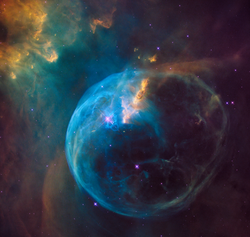NGC 7635

NGC 7635

| Emission nebula | |
|---|---|
H II region | |
| Observation data:J2000epoch | |
| Right ascension | 23h20m48.3s |
| Declination | +61° 12′ 06″ |
| Distance | 7100 to 11000ly(3,400pc) |
| Apparent magnitude(V) | ~10[6] |
| Apparent dimensions (V) | 15′ × 8′ |
| Constellation | Cassiopeia |
| Physical characteristics | |
| Radius | 3 to 5 ly |
| Notable features | Shell aroundSAO 20575 |
| Designations | Bubble NebulaSharpless162 (Sh2-162)Caldwell11 |
| See also:Lists of nebulae | |
NGC 7635, also called the Bubble Nebula, Sharpless 162, or Caldwell 11, is a H II region emission nebula in the constellation Cassiopeia. It lies close to the direction of the open cluster Messier 52. The "bubble" is created by the stellar wind from a massive hot, 8.7 magnitude young central star, SAO 20575 (BD+60°2522). The nebula is near a giant molecular cloud which contains the expansion of the bubble nebula while itself being excited by the hot central star, causing it to glow. It was discovered in 1787 by William Herschel. [6] The star BD+60°2522 is thought to have a mass of about 44 M ☉.
| Emission nebula | |
|---|---|
H II region | |
| Observation data:J2000epoch | |
| Right ascension | 23h20m48.3s |
| Declination | +61° 12′ 06″ |
| Distance | 7100 to 11000ly(3,400pc) |
| Apparent magnitude(V) | ~10[6] |
| Apparent dimensions (V) | 15′ × 8′ |
| Constellation | Cassiopeia |
| Physical characteristics | |
| Radius | 3 to 5 ly |
| Notable features | Shell aroundSAO 20575 |
| Designations | Bubble NebulaSharpless162 (Sh2-162)Caldwell11 |
| See also:Lists of nebulae | |
Amateur observation
With an 8 or 10-inch (250 mm) telescope, the Nebula is visible as an extremely faint and large shell around the star. The nearby 7th magnitude star on the west hinders observation, but one can view the nebula using averted vision. Using a 16 to 18-inch (460 mm) scope, one can see that the faint nebula is irregular, being elongated in the north south direction.
